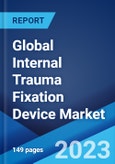Internal trauma fixation devices refer to the biologically inert medical tools implanted for the stabilization of fractured bones in the body. Some of the commonly used devices include cannulated screws, intramedullary nails, hip screws, cables, wires, plates and pins. They are manufactured using stainless steel, tritium, nitinol, polyether ether ketone (PEEK), nickel and titanium and are corrosion resistant and adjustable according to the bone structure. They aid in maintaining the original shape of the bone and facilitate repair by restricting the movement of fractured bones. As a result, they are widely used across hospitals, orthopedic surgical centers and trauma and ambulatory centers.
Internal Trauma Fixation Device Market Trends
The increasing prevalence of orthopedic disorders, along with the rising geriatric population across the globe, is one of the key factors driving the growth of the market. Moreover, the rising incidence of road accidents and sports-related injuries are providing a thrust to the market growth. The internal trauma fixation devices are widely used for elderly patients, which are more prone to fractures and joint dislocation due to osteoporosis and other bone-related disorders. This has further led to the increasing adoption of biocompatible, elastic and fatigue and kink-resistant closure devices, which is also contributing to the market growth. In line with this, the increasing adoption of minimally invasive (MI) surgical procedures for the placement of internal trauma fixation devices is favoring the growth of the market. Additionally, various innovations in implant technologies and the development of cement-augmented transiliacal internal fixators are acting as other growth-inducing factors. These devices provide improved stabilization of fractures in the pelvis. Other factors, including the rising healthcare expenditure capacities of the masses, along with extensive research and development (R&D) activities, are anticipated to drive the market toward growth.Key Market Segmentation
This research provides an analysis of the key trends in each sub-segment of the global internal trauma fixation device market report, along with forecasts at the global, regional and country level from 2023-2028. The report has categorized the market based on product, material and end user.Breakup by Product:
- Closure Device
- Plates and Screws
- Wires
- Clips and Pins
- Rods and Nails
- Cables
- Bone Cement
Breakup by Material:
- Stainless Steel
- Nitinol
- Titanium
- Tritium
- Polyether Ether Ketone (PEEK)
Breakup by End User:
- Hospitals
- Orthopedic Surgical Centers
- Trauma Centers
- Ambulatory Centers
Breakup by Region:
- North America
- United States
- Canada
- Asia-Pacific
- China
- Japan
- India
- South Korea
- Australia
- Indonesia
- Europe
- Germany
- France
- United Kingdom
- Italy
- Spain
- Russia
- Latin America
- Brazil
- Mexico
- Middle East and Africa
Competitive Landscape
The competitive landscape of the industry has also been examined along with the profiles of the key players being Arthrex Inc., B. Braun Melsungen AG, Globus Medical Inc., Johnson & Johnson Private Limited, Medartis AG, Orthofix Medical Inc., Orthopaedic Implant Company, OsteoMed (Berkshire Hathaway Inc.), Smith & Nephew plc, Stryker Corporation and Zimmer Biomet.Key Questions Answered in This Report
1. How big is the global internal trauma fixation device market?2. What is the expected growth rate of the global internal trauma fixation device market during 2023-2028?
3. What are the key factors driving the global internal trauma fixation device market?
4. What has been the impact of COVID-19 on the global internal trauma fixation device market?
5. What is the breakup of the global internal trauma fixation device market based on the product?
6. What is the breakup of the global internal trauma fixation device market based on the material?
7. What is the breakup of the global internal trauma fixation device market based on the end user?
8. What are the key regions in the global internal trauma fixation device market?
9. Who are the key players/companies in the global internal trauma fixation device market?
Table of Contents
Companies Mentioned
- Arthrex Inc.
- B. Braun Melsungen AG
- Globus Medical Inc.
- Johnson & Johnson Private Limited
- Medartis AG
- Orthofix Medical Inc.
- Orthopaedic Implant Company
- OsteoMed (Berkshire Hathaway Inc.)
- Smith & Nephew plc
- Stryker Corporation
- Zimmer Biomet
Methodology

LOADING...
Table Information
| Report Attribute | Details |
|---|---|
| No. of Pages | 149 |
| Published | November 2023 |
| Forecast Period | 2022 - 2028 |
| Estimated Market Value ( USD | $ 9.7 Billion |
| Forecasted Market Value ( USD | $ 13.1 Billion |
| Compound Annual Growth Rate | 5.1% |
| Regions Covered | Global |
| No. of Companies Mentioned | 11 |









